"Weinerus Landtafeln“ Vollständiger Atlas des Hofkupferstechers Peter Weiner
Atlas: 24 Bayerische Landtafeln, genannt auch "Weinerus Landtafeln“ Kompletter Atlas mit Übersichtskarte „Kurtze Beschreibung des gantzen Fürstentumbs Obern und Nidern Bayrn“ Die vorgebundene Übersichtskarte zeigt verkleinert die 24 Kupferstich-Landtafeln dieses Atlasses einschliesslich ihrer Nummerierung von 1 bis 24. Flankiert ist die Übersichtskarte links und rechts mit 36 Stadtwappen bayerischer Kreisstädte, wovon 34 ausgeführt sind und sich links und rechts je ein nicht ausgeführtes Wappen befindet. Es folgen die 24 doppelblattgrossen Landtafeln, wobei sich die Karten (Tafeln) 1 und 2, sowie die Karten (Tafeln) 3 und 4 auf jeweils einer Atlasseite befinden, da sie im Gegensatz zu allen anderen Karten, nur jeweils die halbe Höhe haben. Karte (Tafel) 1 mit Widmung: „Illustrissimo et sereniss. Principi AC DN. D. Alberto Com. Palatino Rheni superioris infer:que Bavariae Duci.“ Karte (Tafel) 3 mit Titel: „Corographia Bavaria“ Karte (Tafel) 4 mit Widmung: „Ad Illustriss. et Sereniss. Principem ac Dominum. Domin. Albertum Comitem Palatinum Rheni utriusq. Bavariae Ducem. Do. Suum Clementiss.“ Karte (Tafel) 5 mit der grossen bayerischen Wappenkartusche. Karte (Tafel) 24 mit einer Darstellung der ,Justitia’, die im Begriff ist, den bayerischen Löwen mit dem bayerischen Rautenwappen zu krönen. Der Löwe ist das Wappentier der Wittelsbacher. Die einzelnen Karten sind schon buchbindergerecht vorbereitet, um, falls erwünscht, zu einer grossen Karte (ca. 156 x 159 cm) zusammengefügt zu werden. Dabei wird die Gesamtkarte von der dekorativen Renaissance-Früchtebordüre umrahmt. Vollständiger Atlas des Hofkupferstechers Peter Weiner, der sich der Holzschnitte bediente, die Philipp Apian (1531-1589) zuvor angefertigt hatte und 1568 als Atlas herausgegeben hatte. Appian besass die Verlagsrechte an seinem Atlas. Als er Bayern 1569 verliess, beauftragte Herzog Albrecht V. seinen Hofkupferstecher Peter Weiner mit der Anfertigung einer ebenbürtigen Karte, die Weiner im Kupferstich-Verfahren herstellte. Der hier vorliegende Atlas ist ein Original aus dem Jahr 1579. Er ist gebunden. Der Zustand der Karten ist sehr gut. Er ist sauber und hat nur minimale, kaum erwähnenswerte Altersspuren. Strassen sind mit roter Tinte als feine Linien von Hand eingezeichnet. Auf den Karten-Rückseiten sind mit schwarzer Tinte in deutscher Schrift säuberlich Städte, Märkte, Klöster, Schlösser, Sitze und Gewässer, aufgelistet. Die Tinte hat nirgends im Atlas auf die Kartenvorderseite durchgeschlagen. Einband: Pappe aus der Zeit. Bestossen und berieben. Buchrücken: Pergament mit handschriftlicher Titelbezeichnung. Buchecken sind noch teilweise in Pergament gefasst Atlas aussen 35.5 x 25.5 cm ( 13.9 x 9.8") Karten Doppelseite: 31 x 41 cm ( 12.2 x 16.1")
Sachgebiete: Atlanten, Bayern, Landkarten
17730,- EUR
Keine Angabe zur Besteuerung
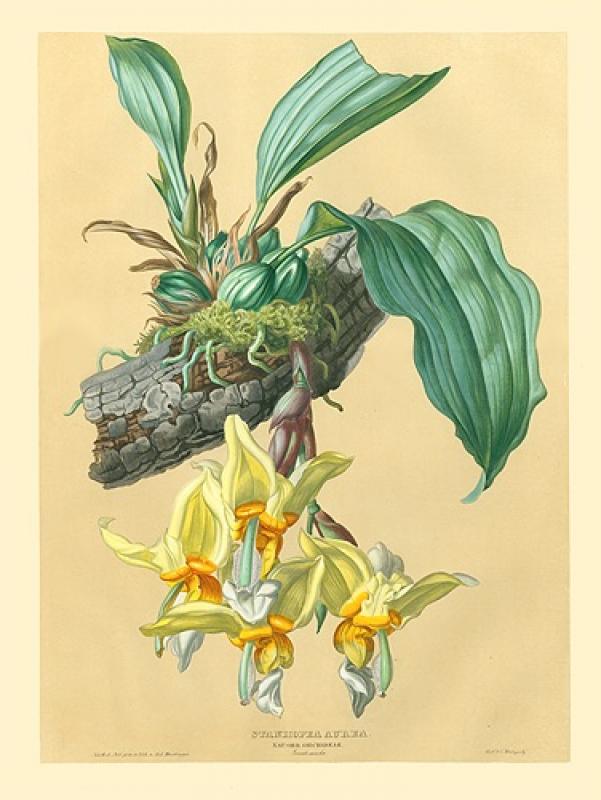
Exquisite prints of Orchids by Anton Hartinger "Paradisus Vindobonensis" (Viennese Paradise) Stanhopea Aurea Nat. Ord. Orchideae Guatemala
Author / Artist: Anton Hartinger, Austrian flower painter and lithographer (1806 - 1890). Title:"Paradisus Vindobonensis" Abbildungen seltener und schoenbluehender Pflanzen der Wiener und anderer Gaerten und Museen. Publisher: K.& K. Hof- und Staatsdruckerei Vienna Dedication: To His Majesty Ferdinand I., Kaiser of Austria, King of Hungary, of Lombardy and Venice. The background story: Anton Hartinger, was a Viennese artist specialized in flower painting. He was a member of the Viennese Academy of Arts from 1843 to 1851. Lacking money to publish his extraordinary large folio size and extensive work on flowers, he sought investors. And he found them. But it took from 1844 to 1860 to publish 20 installments, seldom more than one set per year. Obviously a period of 16 years is a too long a time for publishing a book. It became increasingly difficult to keep the sponsors interested. Some may not even have lived to see the final installment printed. That is why there are only two complete copies worldwide in existence to our knowledge. Only the Vienna Library and the British Library seem to have complete sets. Since the sponsors held only loose prints in their hands it is easily understood why most of these prints did not survive. Print size: ca. 56 x 42 cm. (22 x 16.5")
2120,- EUR
Keine Angabe zur Besteuerung
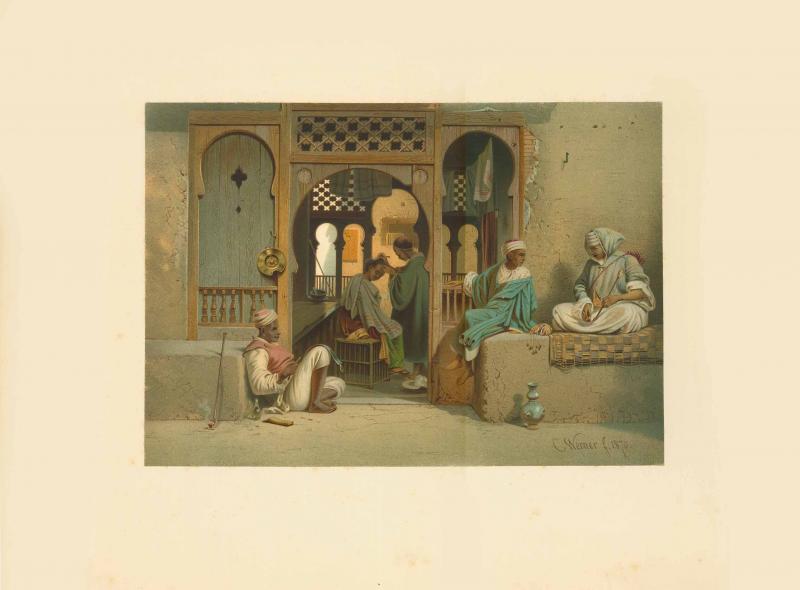
Chromo lithograph after the painting by Carl Werner (1808-1894)
Achmim. - "Barbirladen in Achmim" (Title on accompanying text page) Chromo lithograph after the painting by Carl Werner (1808-1894) Published in: "Nilbilder" Views along the river Nile Published by Artistische Anstalt Gustav W. Seitz Wandsbeck bei Hamburg, 1871 Splendid lithograph printed in beautiful colors. With accompanying German text page. There were 24 chromeo lithographs in the set, published in 4 installments and, after completion, put into a decorative cassette. The elucidating text was contributed by Johannes Duemichen. Traces of age and use (some spotting and soiling) only on underlaying cardboard. Text page has text on both sides. It has also some traces of age and use. Lithograph: 27,5 x 33,4 cm (ca. 10.8 x 13.1") Cardboard sze: 40 x 60 cm (ca. 15.7 x 23.6") They were dedicated 'with the deepest devotion' to "His Imperial and Royal Highness, Crown Prince of Prussia Friedrich Wilhelm"
Sachgebiete: Ägyptologie, Berufe, Kulturgeschichte, Völkerkunde/Ethnographie
179,- EUR
Keine Angabe zur Besteuerung
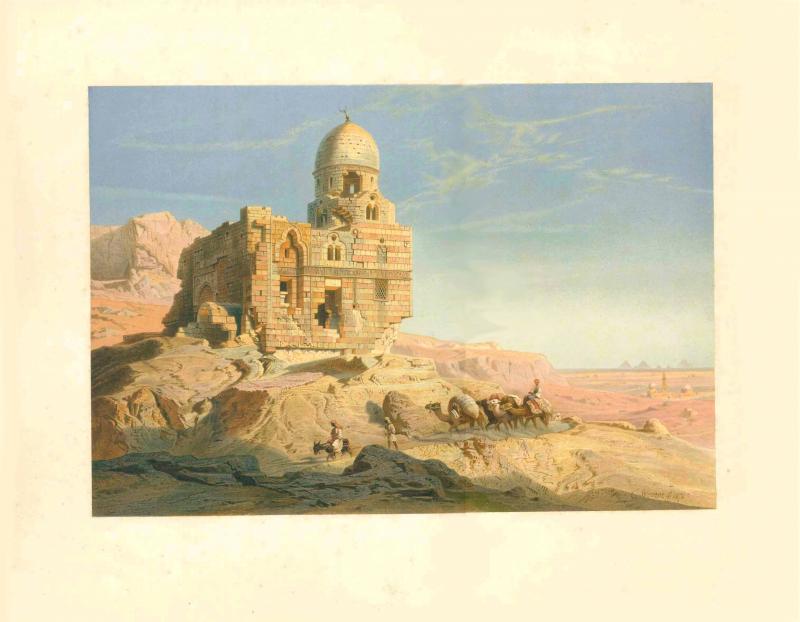
Chromo lithograph after the painting by Carl Werner (1808-1894)
Cairo. - "Die Chalifengraeber von Cairo" Chromo lithograph after the painting by Carl Werner (1808-1894) Published in: "Nilbilder" Views along the river Nile Published by Artistische Anstalt Gustav W. Seitz Wandsbeck bei Hamburg, 1871 Splendid lithograph printed in beautiful colors. With accompanying German text page. There were 24 chromo lithographs in the set, published in 4 installments and, after completion, put into a decorative cassette. The elucidating text was contributed by Johannes Duemichen. Traces of age and use only on underlaying cardboard. Text page has text on both sides. It has also some traces of age and use. Image: 27,6 x 39,7 cm (ca. 10.8 x 15.6") Cardboard sze: 40 x 60 cm (ca. 15.7 x 23.6") Lithograph was mounted fully on underlaying cardboard. Lower right corner bears title, artist, name of publication and publisher's address. Lower margin center bears blind stamp of publisher. The complete set consists of 24 chromo lithographs. They were dedicated 'with the deepest devotion' to "His Imperial and Royal Highness, Crown Prince of Prussia Friedrich Wilhelm"
Sachgebiete: Ägyptologie, Altertum, Archäologie, Geographie
300,- EUR
Keine Angabe zur Besteuerung
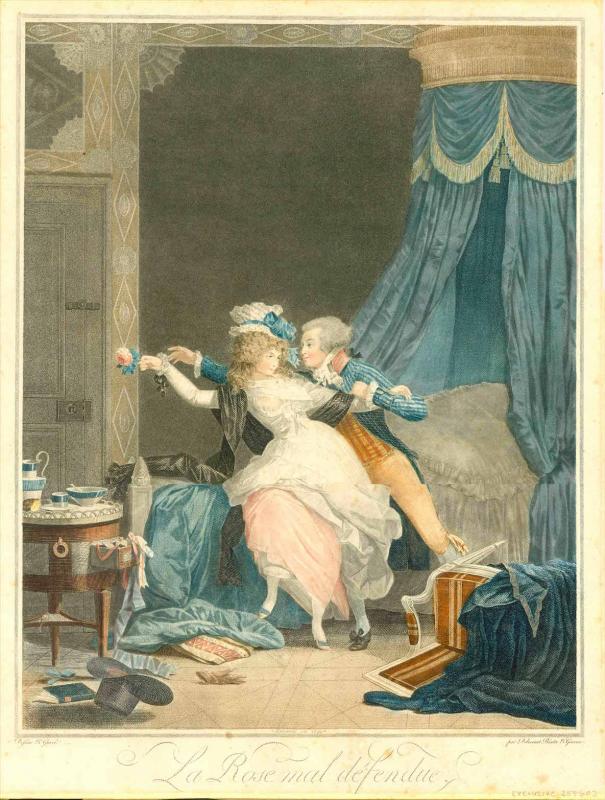
Philibert-Louis Debucourt (1755-1832)
"La Rose mal defendue" "dessine et grave par Deboucourt peintre graveur" Stipple engraving, printed in fabulous colors. Painter and engraver: Philibert-Louis Debucourt (1755-1832) Öfter his own design Paris, dated 1794 Printing copper etchings not just black and white, but also in color was great advancement. In Europe it happened in the 18th century. Severall different plates were used, each with their own color. Debucourt was a master of this technique which needed great precision in order to arrive at a successful result. In this case he used the colors blue, red, rose and brown. The scene is typical for French gallantry. The young lady is more willing than it seems. But she is offering her cavalier a good measure of resistance to his courtship. His hat has rolled off his head, a chair has tumbled to the floor, a book and pillows became victims in the process of tangling. But she is firm, or makes believe that she is determined to keep her ãrose" well out of reach. Very French - if not international. Print is in very good condition. Margins with some faint spotting. 42,4 x 33,3 cm (ca. 16.7 x 13.1")
Sachgebiete: Dekorative Graphik
340,- EUR
Keine Angabe zur Besteuerung
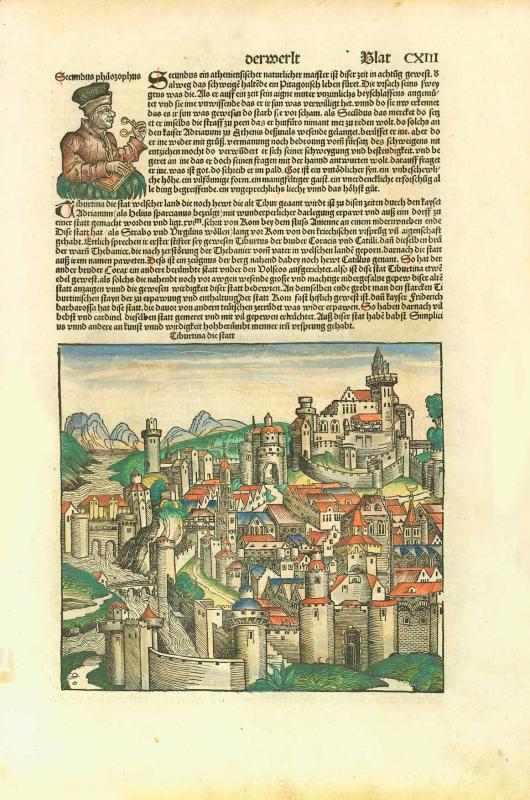
Rome. - "Tiburtina die statt" Das sechst alter der werlt. Lag. CXIII (113) Published in: Nuremberg Chronicle ("Weltchronik" (Liber Chronicarum) Author: Hartmann Schedel. Published: Nuremberg, 1493
Rome. - "Tiburtina die statt" Das sechst alter der werlt. Lag. CXIII (113) Upper left: Portrait of "Secundus philozophus" Most likely holding in his hand the oldest depiction of looking glasses ever in print Type of print: Woodcut Color: Excellent hand coloring Published in: Nuremberg Chronicle ("Weltchronik" (Liber Chronicarum) Author: Hartmann Schedel. Published: Nuremberg, 1493 Text: German edition. Relating text print below image. Tiburtina is nowadays a city fraction of the City of Rome. The text describes it as being mentioned by Strabo and Virgil, supposedly older than Rome and founded by Greek immigrants to Italy. This print is from the very rare GERMAN EDITION of the Nuremberg Chronicle, which was fist published in LATIN in May 1493 and, with a very small German edition, in December 1493. Since the publishers were located in Nuremberg, Germany, they felt they should also publish this important incunabula work in the German language. But among scholars in all of Europe, the Latin language was the common language for communication, while German had a much smaller radius. That's why the Latin edition was the larger of the two. The philosopher, upper left, is depicted with a pair of looking glasses in his hand. It may be safe to speak of the first ever depicted pair of glasses in print history. Reverse side: 9 portraits of, a medical doctor (holding up and viewing a glass of urine), one philosopher - Justinus, three heretics and three bishops, among them Apollinaris.
Sachgebiete: Geschichte, Graphik, Italien, Optik
480,- EUR
Keine Angabe zur Besteuerung
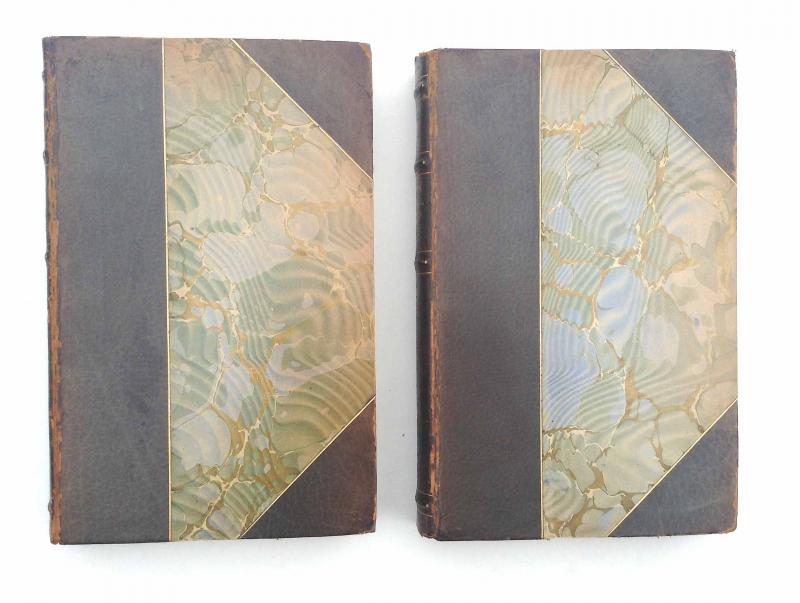
"Travels in Central America, Particularly in Nicaragua: With a Description of Its Aboriginal Monuments, Scenery and People, Their Languages, Institutions, Religion, & c., illustrated by numerous maps and coloured illustrations, by E. G. Squier, Late Charg
"Travels in Central America, Particularly in Nicaragua: With a Description of Its Aboriginal Monuments, Scenery and People, Their Languages, Institutions, Religion, & c., illustrated by numerous maps and coloured illustrations, by E. G. Squier, Late Charge-D'Affaires of the United States to the Republics of Central America" Volumes I and II. Published by D. Appleton & Co., New York, 1853. Volume I - 424 pages. Volume II - 452 pages Size. 8vo. There is an Ex Libris (see photo) inside the cover from William H. Bartlett. It was William H. Bartlett (1850-1918), a wealthy American business man purchased, in 1902, 205 000 acres of land near Vermejo in New Mexico from the Maxwell Land Grant Company.There he built three residences, one for himself and his wife, the Casa Grande, the other two for their two sons. Later he expanded this property to 300 000 acres. He named his vast possession The Vermejo Club, where, the most important business men regularly met and former US-presidents were guests as well as celebrities from Hollywood. Bartlett owned an important and valuable library. For his "Ex Libris" sticker he used the fire place of his mansion, Casa Grande, for background decoration. Ted Turner bought the property in 1996. The Casa Grande is still standing, and as far as we know, Ted Turner is using it as his residence in Vermejo. The set of two books we offer here were once part of Bartlett's library, which was dissolved after his death. Both volumes have Bartlett's original ãEx Libris". Please see photos. Hardcover, partially leather. Both books are in good, solid condition with signs of age and use on the covers. No loose pages. Texts and illustratons are in good, clean condition. On the page before or after each illustration is a light brown imprint from the colored lithograph. See photos.
Sachgebiete: Archäologie, Indigene Kulturen
555,- EUR
Keine Angabe zur Besteuerung
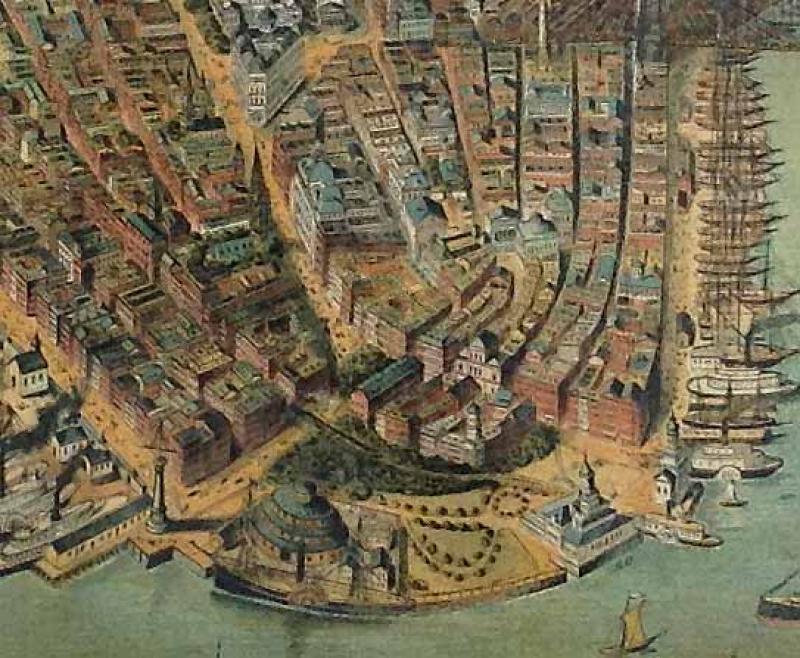
Bird's Eye View of the City of New York. Anonymous chromolithograph showing the Island of Manhattan in its center from an angular aerial position.
Bird's Eye View of the City of New York. Anonymous chromolithograph showing the Island of Manhattan in its center from an angular aerial position. Manhattan's buildings details are nicely define, not just as a plan but each building showing its architectural specifications, windows, roof tops etc. Same is true of the buildings of Brooklyn, Jersey City and Hoboken. In the foreground we are looking at Governors-Island and a busy News York harbor with plenty of sail ships, paddle steamers and sailboats. To the left we are looking at the Hudson River, to the right we see the East River with spectacular Brooklyn Bridge spanning it. When it opened in 1883 it was the first fixed crossing of the East River and, world-wide, the longest suspension bridge, 1595 feet (486 m) long: An impressive piece of architecture! What makes this view of New York so special is the artist's dedication to detail. Unfortunately the chromo lithograph does not reveal the name of the artist, nor the publisher or the printing date. Since Brooklyn Bridge shows as finished architecture, we may assume that this spectacular view was printed in the mid 1880ies. We may also assume that it was printed in New York, probably as a commissioned piece of art, maybe by a N.Y. galerist. Condition: The chromolithograph is mounted on cardboard, a happy circumstance which helped to keep it unfolded. The lithograph has a transparent glossy surface, which protected it through all these years. Age has slightly darkened the original color. Condition specifics worth mentioning: Lower right margin corner is bent backward, only the extreme corner missing - however not interfering with image. There are minor scratches in the glossy surface and some other minor traces of age and use. All four margins have some rubbing. In general this large spectacular half bird's eye view of New York City is in better than good condition. Type of print: Chromolithograph Artist: Anonymous Publisher / Printer: Unknown Time of printing: Ca. 1885 1890 Measurements: 60,3 x 82 cm (ca. 23.7 x 32.3")
Sachgebiete: Landkarten, Nordamerika
5550,- EUR
Keine Angabe zur Besteuerung